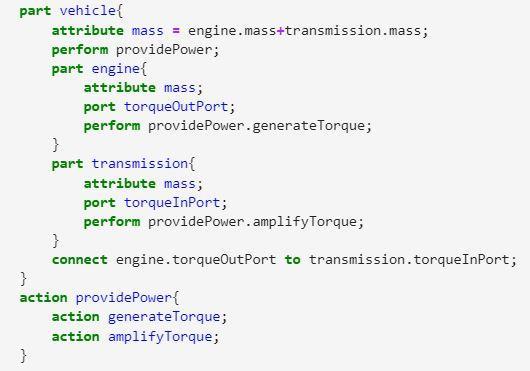
25 minute read
FEATURE ARTICLE
the requirements in the SysML v2 request for proposal (RFP) that was issued by the OMG in December 2017, and the SysML v2 API & Services RFP which was issued by the OMG in June 2018. The language specification for SysML v2 was submitted to the Object Management Group on February 20, 2023, for approval as a beta specification. The beta specification enters the finalization phase and provides tool vendors that are implementing the specification an opportunity to submit issues for resolution prior to issuance of the final adopted specification which is anticipated in 2024.
The objectives for SysML v2 are to facilitate improvements in both adoption and effectiveness of MBSE when using SysML v2 versus SysML v1. In particular, the objectives are to improve the language in the following ways:
Advertisement
• Precision of the language leading to less ambiguity
• Expressiveness of the language
• Consistency across the various aspects of the language
• Interoperability with other engineering models and tools
• Usability by both developers and consumers of models
• Extensibility for domain specific applicationsSummary level changes in SysML v2
The following are the summary level changes in SysML v2 relative to SysML v1 that provide the basis for achieving the SysML v2 objectives:
Metamodel
SysML v2 contains a new metamodel that extends the Kernel Modeling Language (KerML), which was developed as the syntactic and semantic foundation for SysML v2. SysML v1 was based on the UML metamodel, which was originally developed for software modeling. The SysML v2 and KerML metamodels were architected to leverage many of the UML modeling capabilities along with additional capabilities to address the needs for modeling systems. The SysML v2 metamodel provides a formal semantic underpinning, consistent terminology, and improved support for modeling deeply nested hierarchies of structure, behavior, and requirements and their cross-cutting relationships. It also provides a library-based mechanism to further extend the language for domain-specific applications.
Graphical and textual syntax
SysML v2 can be expressed using a standard textual syntax in addition to a graphical syntax, whereas SysML v1 can only be expressed using a standard graphical syntax. The complementary ways for expressing the model in SysML v2 can improve understanding and ease of use. In addition, SysML v2 provides a flexible view and viewpoint mechanism and formal specification of the graphical and textual syntax to enable further customization of the views to meet the needs of the stakeholders.
Application Programming Interface (API)
SysML v2 includes a standard API and an associated standard set of services to navigate, query, and update the model. This enables interoperability with other tools and software applications throughout the life cycle of a system development.
General changes in SysML v2 language
The following section describes some of the changes in SysML v2 relative to SysML v1 that apply across the language.
Note: Examples of the SysML v2 textual syntax in this paper were created using the open-source pilot implementation that was developed as part of the SysML v2 submission development effort. The graphical views of the SysML v2 model were created using a prototype visualization tool integrated with the pilot implementation, based on an open-source application called Plant UML. The quality of the graphical visualization is limited but will be substantially improved when commercial tools become available.
Textual notation
A major change when modeling with SysML v2 is the introduction of a textual syntax. The textual syntax includes a standard expression language to represent logical and quantitative expressions that enable solvers to unambiguously interpret SysML v2 models. The textual syntax can also be used to exchange models.
The textual and graphical syntax provide different renderings of the same underlying model (e.g., the abstract syntax and semantics). The use of the textual syntax and the graphical syntax provide complementary ways to create, modify, and view the model. The textual syntax is often an effective way to create, view, and modify small, detailed portions of the system model such as a calculation with expressions or a detailed algorithm. At the same time, the graphical syntax is often an effective way to create, view, and modify cross-cutting architectural views of the system including interconnections, allocations, and interactions.
An example of a textual representation for a simple vehicle model is shown in Figure 1. The textual notation shows a vehicle that has an attribute mass. The vehicle is composed of two parts, an engine and a transmission which each have an attribute mass. The vehicle mass is the sum of the engine.mass and the transmission.mass.
The engine and transmission have ports torqueOutPort and torqueInPort respectively that are connected as shown by the connect statement.
The vehicle also performs an action providePower that refers to the providePower action below which is composed of the generateTorque and amplifyTorque actions. The engine and transmission each perform actions to generateTorque and amplifyTorque respectively.
The corresponding graphical views for the vehicle part, the interconnection between the engine and transmission, and the decomposition of the providePower action are shown in Figure 2. As the model becomes more complex, it is evident that the graphical views are critical for understanding the complex relationships that span the system model, while the textual syntax enables a close-in look at selected portions of the model.


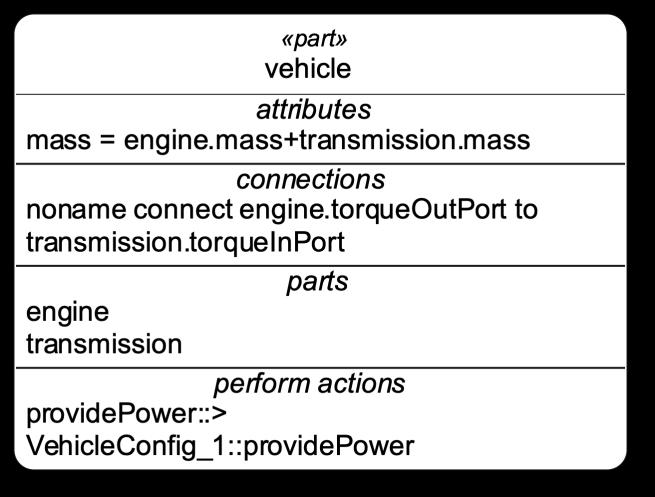
Definition and usage pattern
Another major change to SysML v2 is the consistent application of the definition and usage pattern. The definition and usage pattern is intended to enable reuse by creating usage elements that are defined by a common definition element. A simple example is a definition of a Tire where the front tires and the rear tires are both usages that are defined by Tire. However, the usages for front and rear tires can vary in terms of their tire pressure, tire wear, and their connections to different parts of the vehicle. The ability to define a common definition element while adapting each usage to its context can significantly reduce the modeling effort and the potential for introducing modeling errors.
SysML v1 introduced the definition and usage concept informally. For example, a block is considered a definition element (i.e., the type) and a part property is considered a usage element that is typed by a block. Similarly, an action is considered a usage of an activity. However, the actual relationship between an action and an activity is quite different from the relationship between a part property and a block. In addition, the usage cannot be modified directly to adapt to its context. For the front and rear tire examples referred to previously, the block Tire must be specialized to be a FrontTire and a RearTire each having their own specialized features as shown in Figure 3a. The parts for the front tires and rear tires are then typed by these respective blocks.
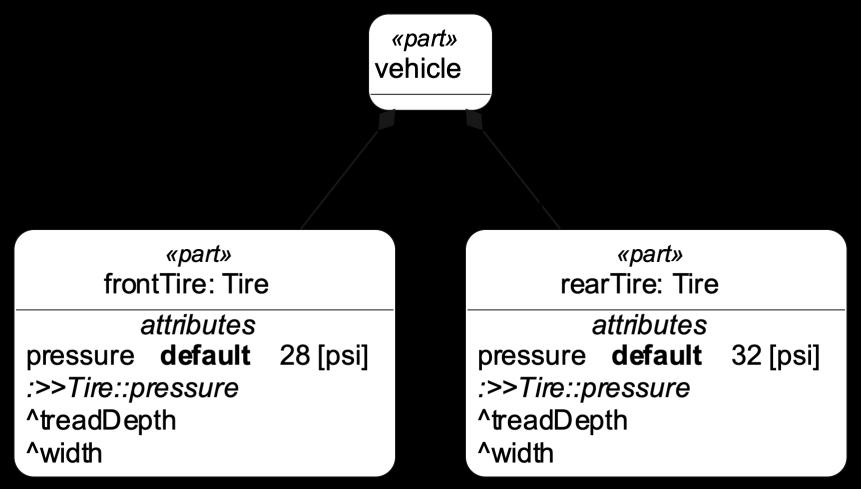
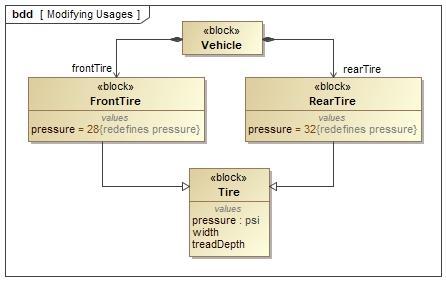
In SysML v2, the definition and usage pattern is designed into the metamodel at the root level. Virtually all elements in SysML v2 follow a consistent pattern of definition and usage. The relationship between a usage and its definition is a kind of specialization. This enables a usage to inherit the features from its definition which can then be redefined or subsetted, and new features can be added. This aspect of the language makes it more straightforward than SysML v1 to modify a design configuration and/or adapt it to its context. The usages for the front tire and rear tires in Figure 3b have been directly modified to modify the tire pressure. The carrot symbol (^) indicates the treadDepth and width are inherited from the definition but have not been modified.
The terminology is also consistent with this definition and usage pattern. For example, a part usage is defined by a part definition, an action usage is defined by an action definition, and a requirement usage is defined by a requirement definition. The key words are shortened to further simplify their use. For example, the key word for part usage and part definition is part and part def respectively.
Table 1 highlights some of the SysML v2 concepts that apply the definition and usage pattern, and the corresponding concepts and terminology in SysML v1.
SysML v2 SysML v1 part / part def part property / block attribute / attribute def value property / value type port / port def proxy port / interface block action / action def action / activity state / state def state / state machine constraint / constraint def constraint property / constraint block requirement / requirement def requirement connection / connection def connector / association block view / view def view
The regular application of the definition and usage pattern to virtually all definition and usage elements in SysML v2 including structure, behavior, and requirements and the capability it provides enhances reuse and usability and facilitates machine interpretation of the models.
Decomposition
In SysML v1, a system decomposition is accomplished by defining a block for the system. The block contains part properties corresponding to the components of the system. To further decompose the system, the components must be typed by blocks, and those blocks must contain the next level of part properties. This applies to any level of nesting. The example in Figure 4a shows two levels of nesting for a Vehicle that is composed of a leftWheel and a rightWheel both typed by Wheel, and the Wheel is composed of lugbolt1 typed by Lugbolt.
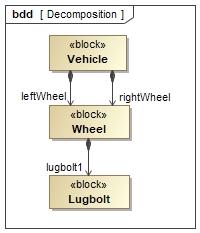
In SysML v2, usages can be decomposed directly so that a system can contain parts that contain other parts which can be further decomposed to any level of nested parts. This is generally a more natural way to represent a system decomposition. Analogous with the SysML v1 model in Figure 4a, the SysML v2 model in Figure 4b represents a vehicle part that is composed of a leftWheel and a rightWheel and each wheel is composed of a lugbolt1.
Figure 4b. SysML v2: The vehicle part decomposition is more intuitive and reduces ambiguity
The SysML v2 part decomposition reduces ambiguities that occur in SysML v1 when parts are nested more than one level deep. For the SysML v1 model in Figure 4a, the lugbolt1 on the leftWheel is indistinguishable from the lugbolt1 on the rightWheel. However, there is no ambiguity with the SysML v2 model in Figure 4b where the leftWheel and rightWheel each have their respective lugbolt1.

Membership relationship versus containment
In SysML v1, a package contains packageable elements such as other packages, types, and dependencies. However, this meta-relationship does not appear explicitly in the model browser, but it does show on a diagram as a line with a crosshair on the owner end. In SysML v2, this relationship is a concrete relationship called a membership relationship that is explicitly part of the model. This relationship is not limited to packages but applies more generally to relate any namespace to its members. This results in the SysML v2 model having a true graph-like structure that enables navigation and other benefits. The downside is that it increases the number of relationships the model must store but this is not necessarily a significant issue with today’s computational and memory capacity.
In SysML v1, a decomposition relationship is modeled with an association. In SysML v2, a decomposition relationship is modeled as a specialized kind of membership called a feature membership. A part or part definition that is composed of other parts is related to each of its nested parts by a feature membership relationship. The relationships shown in Figure 4b are feature membership relationships and not associations. The feature membership can be composite or referential analogous to a composite or reference association in SysML v1. A part or part definition can contain a reference part that is bound to a part that is being referred to. For example, consider a trailer that is hitched to a car. The trailer hitch is composed of a hitchBall that is mounted on the vehicle (i.e., car) and a trailerCoupler that is mounted on the trailer. The hitchBall and the trailerCoupler are part of the trailerHitch but can be considered reference parts of the vehicle and the trailer respectively. In this case, the hitchBall on the vehicle and the trailerCoupler on the trailer are bound to the hitchBall and the trailerCoupler on the trailerHitch as shown in Figure 5a. The binding connection is annotated with an ‘=’ symbol. This is the same way reference parts are bound to a part in a SysML v1 internal block diagram as shown in Figure 5b.
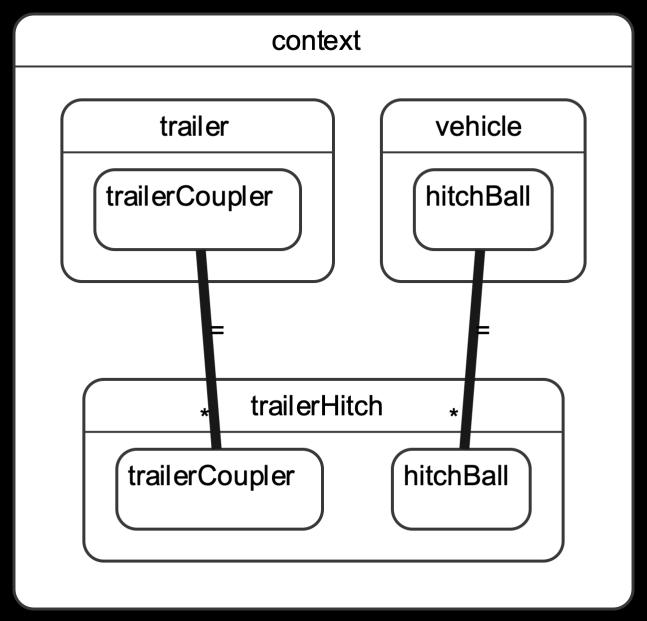
SysML v1 uses different kinds of relationships to relate its type to its features. As noted above, in SysML v1, a block is generally related to its parts through an association, while a block can contain a port without an association. In addition, a block can contain a classifier behavior such as a state machine or activity. In SysML v2, a part or part definition contains analogous parts, ports, and behaviors as well as many other kinds of features that are all related to its owner using kinds of composite or referential feature memberships. This coupled with the consistent definition and usage pattern described above provides for a more consistent approach to modeling a system in SysML v2.
Variability modeling
SysML v1 provides a capability to model variability that includes the use of specialization and multiplicities. The example in Figure 6a shows a VehicleFamily that is modeled as a superset of potential valid configurations that includes an Engine with specializations for a 4 cylinder engine and a 6 cylinder engine, a Transmission with specializations for a manual transmission and an automatic transmission, and an optional Sunroof with multiplicity 0..1. The Engine is composed of 4..6 cylinders with specializations of Cylinder for a small diameter and large diameter. The other parts of the VehicleFamily include the driveshaft, frontAxleAssembly, and rearAxleAssembly which do not include specializations.
The VehicleFamily contains a constraint such that if a 4 cylinder engine is selected, then a manual transmission must be selected to be a valid configuration, and similarly, if a 6 cylinder engine is selected, then an automatic transmission must be selected to be a valid configuration.
A particular variant configuration can be defined by specializing the vehicle family and redefining each of the parts to reflect design choices. Two variant configurations are shown in Figure 6b including a Vehicle_Economy that has an engine_4Cyl and no sunroof (i.e., multiplicity [0]), and a Vehicle_Luxury that has an engine_6cyl with large diameter cylinders and a sunroof (i.e., multiplicity [1]). The constraints can be evaluated to confirm that the configurations are valid which means that the Vehicle_Economy must have a manual transmission and the Vehicle_Luxury must have an automatic transmission. Both configurations inherit the driveshaft, frontAxleAssembly, and rearAxleAssembly

SysML v2 introduces explicit concepts to support variability modeling including the concept of variation and variant. A variation can be used to identify any usage element such as an attribute, part, port, action, or requirement as a point of variation. Similarly, a variant identifies a particular choice at a variation point. A selection at one variation point can constrain a selection at another variation point using a standard SysML v2 constraint. In a similar way as described for SysML v1, the superset model of a vehicleFamily is shown in Figure 6c. This model includes the set of variations that can be nested to any level. A variant configuration is created by specializing the superset model and selecting a variant for each variation subject to the variability constraints. The equivalent selected variant configurations for the vehicle_Economy and vehicle_Luxury are shown in Figure 6d.

The explicit concepts for variation and variant along with the ability to formally specify variability constraints provides a base capability for variability modeling that extends the expressiveness of SysML v2 over SysML v1.
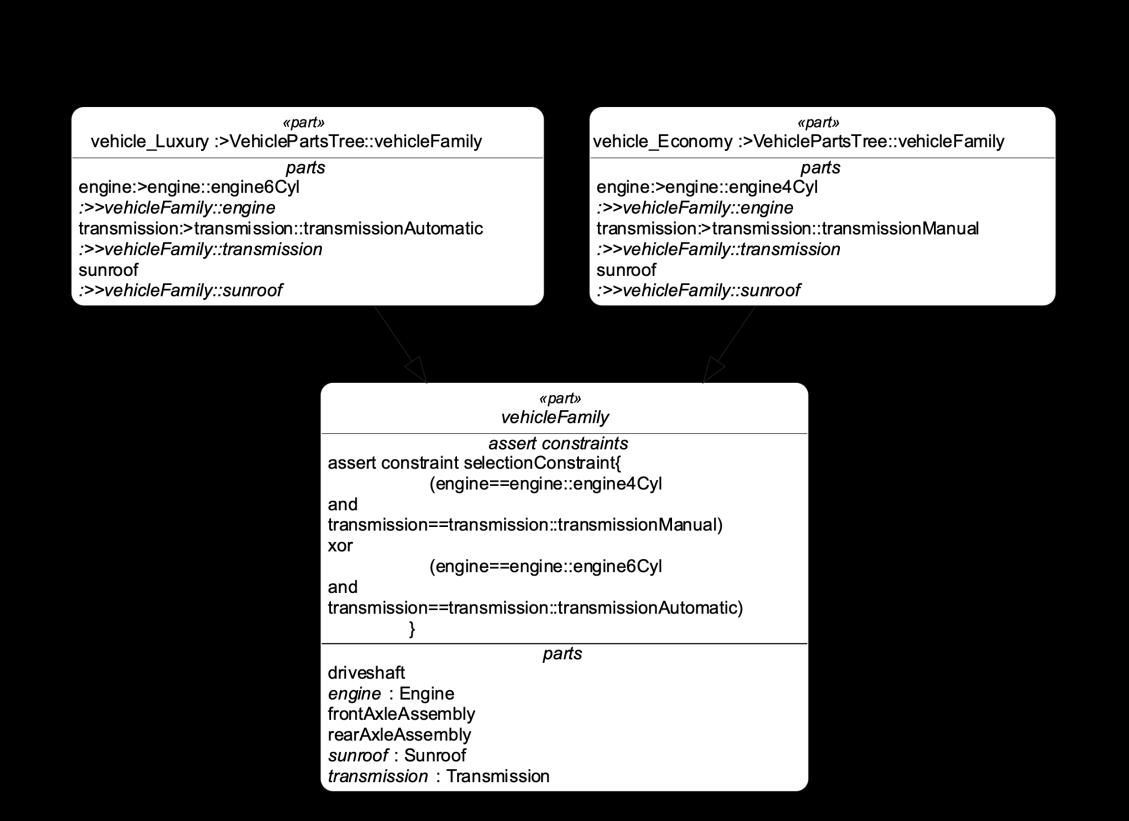

Individuals and snapshots
In SysML v1, an instance specification is used to represent a particular instance of a classifier such as a block. For example, consider the block Vehicle in Figure 7a that has a value property vin that is typed by Integer, and a value property mass typed by the value type kilogram, and a value property speed typed by the value type km/h. The vehicle identification number (vin) is used to uniquely identify a particular Vehicle. An instance of the block Vehicle called vehicle_1 can have the values vin=1 and mass=2000 kg. Additional instances of Vehicle must be created for each point in time. In Figure 7a, the instances vehicle_1_t0 and vehicle_1_t1 are added for times t=0 and t=5 along with their corresponding values of speed.

SysML v2 introduces the concept of individual and snapshot. An individual represents a particular definition element with a unique identity. For example, Vehicle_1 can be defined as an individual of the part definition Vehicle. Each individual has their own unique lifetime. Different points in its lifetime can be represented as snapshots. For the example above, the vin and mass are attributes of Vehicle_1 that are unchanged across its lifetime but speed is an attribute of Vehicle_1 whose value changes across its lifetime. Vehicle_1 can contain snapshots corresponding to different times in its lifetime that contain specific values of the speed of the vehicle.
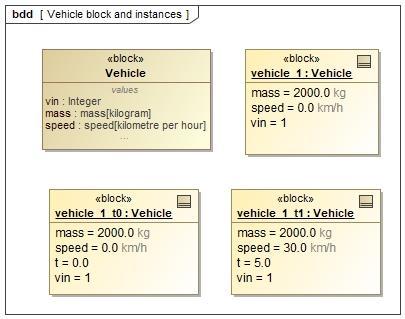
SysML v2 clearly delineates the concept of unique identity of an individual from the snapshots that represent different points in the individual’s lifetime. As a result, SysML v2 makes it easier than SysML v1 to express concepts such as Vehicle_1 and the state of Vehicle_1 as it changes across its lifetime.
4D semantics
SysML v1 is supported by execution semantics that are specified as part of the precise semantics of UML which describe how instances change over time. SysML v2 is grounded in a precise declarative semantics that specify assertions that must be true and correspond to an interpretation of the real world. The semantics are specified in terms of first order logic and are heavily based on the concepts of classification (e.g., classifiers, features, and specialization).
The semantics also give meaning to temporal and spatial concepts. The general concept of an occurrence has temporal extent which is defined by the lifetime of an occurrence. All structural and behavioral entities including items, parts, and actions are kinds of occurrences. Portions of a lifetime are specified as time slices, and a snapshot is a time slice with zero-time duration. The semantics of succession assert that one portion of a lifetime occurs after another. SysML v2 also provides the semantics to quantify time using a default or user specified clock.
A spatial item is a kind of occurrence with spatial extent. The semantics enables spatial items to have a one-, two-, or three-dimensional shape that can be positioned and oriented relative to a coordinate frame. The semantics give meaning to concepts such as inside, outside, or on the boundary of a spatial item. Topological operators provide the ability to define unions, intersections, and subtractions of shapes, and vector math can be applied to define coordinate transformations.
The semantics provide expressiveness and precision that enable sophisticated analysis to be performed on SysML v2 models well beyond what is possible in SysML v1.
Language extension
SysML v1 provides a language extension capability that includes profiles with stereotypes to represent domain specific concepts. SysML v1 enables a stereotype to be defined as an extension of an existing SysML v1 concept. Stereotype properties and constraints can be added to the stereotype. For example, a stereotype «hardware» can be defined that extends block. Stereotype properties for the hardware manufacturer and age can be added. A constraint can be included to restrict the age of the hardware so that its manufactured date must be less than 10 years. This stereotype can then be applied to any block to represent a hardware item. The manufacturer, age, and the constraint can be specified in natural language or in another language so that the constraint can be evaluated.
A block for a generic hardwareItem can also be defined which constrains the characteristics of any hardwareItem such as adding a value property for mass to this block. The stereotype hardware can be applied to this block.
The example in Figure 8a shows a SysML v1 block definition diagram of a Control Subsystem that is composed of a hardware Processor and software Controller, and the Controller is allocated to the Processor. The hardware extension is applied to the Processor and the software stereotype is applied to the Controller
SysML v2 provides an extension capability that provides additional capabilities for representing domain specific concepts. An extension can be defined using metadata that is analogous to defining a SysML v1 stereotype with stereotype properties and constraints. The constraint can be expressed using the SysML v2 expression language.
Figure 8b shows the hardware extension in SysML v2 that corresponds to the SysML v1 extension in Figure 8a. The metadata extension for hardware is analagous to the stereotype hardware in the SysML v1 example and includes metadata properties for manufacturer and age. The constraint restricts the age of the hardware to be less than 10 years. The constraint can be expressed directly in SysML v2 and can be a model-level evaluable expression that a conformant tool can check. The SysML v2 hardwareItem also includes a restriction that the subparts of a hardwareItem must also be hardwareItems, which would not be possible to specify directly in the SysML v1 model. In SysML v1, an additional constraint must be imposed to ensure that the hardware stereotype is applied to any subclass of hardwareItem. This is accomplished automatically in SysML v2

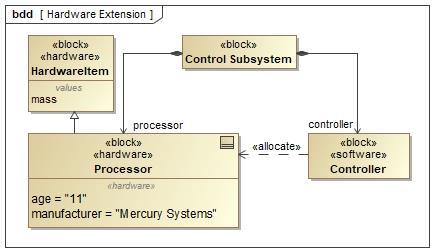
Short name and alias
SysML v2 provides a general capability for providing a short name to augment the name of any element. The short name is included in brackets prior to the name and can be used to provide a numerical identifier. An example is a short name for a mass requirement such as the following: <’3.2.3.1’> massRequirement.
Any element can also have any number of aliases that apply to a particular namespace. An example is a Sport Utility Vehicle with the alias SUV as shown in Figure 9. The figure also shows a part defined by the alias SUV with a short name <1.1>.

This SysML v2 capability enhances expressiveness and usability over SysML v1 which does not include the ability to define to a short name or alias for any element.
Specific changes in SysML v2 language
In addition to the changes above that apply generally to the language, the following section describes some of the changes in SysML v2 relative to SysML v1 that apply to specific concepts within the language.
Port
In SysML v1, a port can be a proxy port typed by an interface block or a full port typed by a block, or a UML port typed by an interface. In SysML v2, the language was simplified to have a single concept of a port usage defined by a port definition. The port usage and port definition align with the SysML v1 proxy port and interface block. The equivalent of a SysML v1 full port can be represented as a part on the boundary that can connect to other parts external to its owning part. SysML v2 can represent the equivalent of a UML port by including actions as directed features of the port in place of the required and provided operations on UML ports.
A SysML v2 port can have directed features such as data, liquid, or heat that flows into or out of a port. An input or output of an action can be bound to a directed feature of a port to eliminate ambiguity as to which port it flows in or out of. The port can also contain features that are not directed such as voltage. The features can be constrained and evaluated, such as the interface constraints on across and through variables of connected ports. Like any other features, ports can be decomposed and specialized. The simplified port concept in SysML v2 significantly improves usability and precision over the SysML v1 port concepts.
Quantities and units
SysML v1 introduced a comprehensive library called Quantities, Units, Dimensions and Values (QUDV) to specify quantities and units consistent with the international metrology standards. This library enabled quantity and units to be associated with a value type. For example, a value type can represent a real number for the quantity length and the unit meter
SysML v2 further improved this library to make it more precise, usable and expressive. In SysML v1, a different value type is required for each unit. For example, a different value type is required to type a value property in meters and a value property in feet. In SysML v2, the attribute definition analogous to a value type is associated with the quantity and not the unit. For example, an attribute defined by an attribute definition for the quantity length can be represented as length in meters or feet. This makes quantities and units much easier to use.
The SysML v2 textual syntax can be used to perform quantity arithmetic to create new quantities and units from more primitive quantities and units. An example is the quantity for fuel consumption which can be derived from the more primitive quantities of length / volume and then expressed in the unit of miles per gallon or liters per kilometer (if the quantity is inverted). SysML v2 also enables dimensional analysis to check the quantities and units for compatibility. The expressiveness has been further increased by adding US Customary Units to the standard library.
Requirement
A requirement in SysML v1 includes an id and a text statement to represent a shall statement such as the MassRequirement and VehicleMassRequirement shown in Figure 10a. A requirement can be extended to include additional attributes. A non-normative extension was added in SysML v1.5 to support property-based requirements which enables a requirement to be augmented by parametric constraints. This is intended to provide the ability to express the requirement with a parametric constraint in addition to a text statement.
Figure 10a. SysML v1: A Mass Requirement and Vehicle Mass Requirement
A requirement in SysML v2 is a kind of constraint. In addition to the id and text statement, a SysML v2 requirement can leverage the SysML v2 expression language to formally express a constraint expression that can be evaluated as true or false. For example, the constraint for a mass requirement can be expressed as {massActual <= massRequired}. The evaluation of the constraint can compare the actual mass from either an analysis or a test and determine whether the requirement is satisfied. In addition, a SysML v2 requirement can include assumed constraints which must be evaluated to true for the requirement to be applicable. The requirement follows the definition and usage pattern so that a definition can specify a generic requirement and a usage can be specific to its context. An example of a massRequirement that is defined by a more general MassRequirement is shown in Figure 10b. The massRequirement includes an assumption that the fuelMass <= 40 kilgorams. The SysML v2 requirement is more precise, expressive and usable than a SysML v1 requirement.
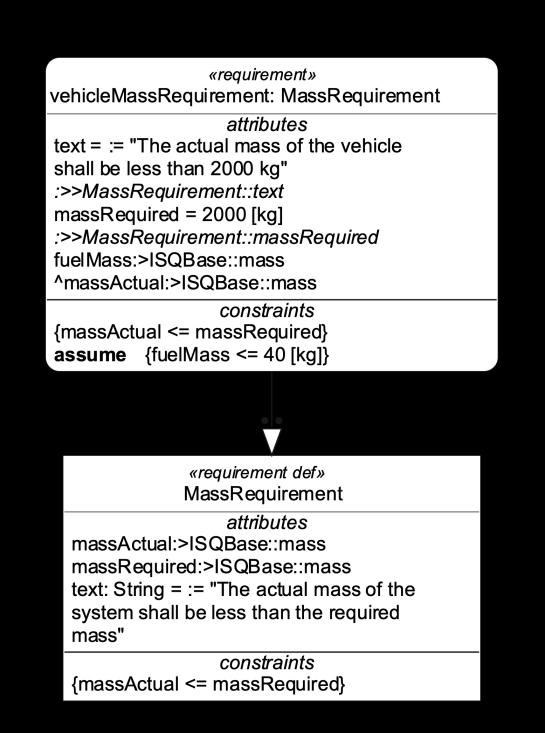
Annotations
SysML v1 includes the concept of a comment that can be used to annotate any kind of element. A single comment can annotate multiple elements and any element can be annotated by multiple comments.
SysML v2 provides significant improvements in the ability to annotate elements. A SysML v2 comment is a kind of annotating element that can annotate any other element. Unlike SysML v1, the annotation relationship between the annotating element and the annotated element is an actual relationship. This enables annotations to be navigated like any other relationship.
A comment is an annotating element that provides additional information about the element it is annotating. In SysML v2, this concept is further elaborated by defining metadata as a special kind of annotating element that can have additional structure. A metadata definition is a kind of attribute definition that can contain additional attributes with values. This enables structured metadata to annotate any kind of element.
SysML v2 also includes standard library extensions of metadata for risk, status, and other kinds of annotating information. The concept of metadata is also used to define the language extension mechanism that correspond to a SysML v1 stereotype as described previously.
A textual representation is another kind of annotating element that includes a language and body. A textual representation can annotate any element like any other annotation. For example, a textual representation can annotate an action with an expression that is defined in another language, similar to a SysML v1 opaque action. The SysML v2 annotating elements provide consistency and expressivity well beyond the capability of a SysML v1 comment.
Cases including use cases, analysis cases, and verification cases
SysML v1 includes concepts for use case and test case. A use case specifies a behavior by defining how the subject interacts with external entities called actors. A test case specifies how a requirement is satisfied.
SysML v2 includes a general concept of a case that contains a subject, actors, an objective, and a set of actions that are used to satisfy the objective and return a result. This general concept is specialized for use cases, analysis cases, and verification cases. This provides a consistent way to represent these concepts as well as a basis for further extensions such as for specifying assurance cases and safety cases.
The use case provides a way to specify interactions between a system or enterprise and external entities. An analysis case describes the actions needed to perform an analysis such as a set of calculations. A special kind of analysis case called a trade study is in the standard SysML v2 library. The analysis case adds capabilities beyond what a SysML v1 parametric diagram can do to specify an analysis. A verification case describes the steps needed to verify that a system or other element satisfies its requirement and provides a more general capability than a SysML v1 test case, such as a standard way to specify verification objectives.
Other differences
SysML v2 includes many other concepts that increase the precision, expressiveness, consistency, and usability relative to SysML v1 which can be the subject of future publications. Examples include enumeration, item, n-ary dependency, allocation, cause-effect relationship, filter expression, and others.
Interoperability
SysML v1 includes the XML Metadata Interchange (XMI) standard as a means for serializing a model and interchanging the serialized model file with other tools. In addition, SysML v1 tool vendors typically provide a custom application programming interface (API) to provide access to their SysML v1 models.
SysML v2 significantly increases interoperability beyond SysML v1 by providing a more robust model interchange standard and a standard API to access the systems model from a conformant SysML v2 tool. In addition to XMI as a standard for model interchange, SysML v2 also includes a JSON representation which is consistent with the commonly used REST interface that many modern tools support. The textual syntax also provides a means for model interchange subject to the limitation that the element id is not directly available.
As noted in an earlier section, SysML v2 includes a standard API and associated standard set of services to navigate, query, and update the model. This capability enables interoperability with other tools and software applications and improves the ability to leverage the system model as part of the broader digital engineering environment. Other applications can access the SysML v2 model in a standard way and operate on this data, and then return results to the SysML v2 modeling tool to further update the system model.
The Systems Modeling API & Services specification also includes standard recipes for performing higher level procedures that support systems engineering activities. Examples include a standard way to return a parts decomposition, action decomposition, or requirement decomposition. The consistency of the SysML v2 language facilitates the development and maintenance of additional standard procedures to support other systems engineering activities such as change impact assessments.
Summary
SysML v2 was developed to address many of the limitations of SysML v1 by improving the precision expressiveness, consistency, usability, extensibility, and interoperability of the language. The result is a language that can improve adoption and effectiveness of MBSE with SysML that will scale with increasing system complexity.
SysML v2 was rearchitected and redesigned to meet the requirements in the SysML v2 RFP. It includes a new metamodel that is not based on UML, the introduction of a textual syntax in addition to the graphical syntax and a more flexible view and viewpoint mechanism for presenting the model information to stakeholders. SysML v2 also includes a new standard API that enables interoperability with other engineering models and tools.
There are many differences between SysML v2 and SysML v1 that are of a general nature and apply across the SysML v2 language. This includes the consistent definition and usage pattern, usage-based decomposition, a reified membership relationship, variability modeling, individuals and snapshots, and 4D semantics. In addition, there are many differences that relate to specific modeling concepts such as ports, quantities and units, requirements, cases, annotations, and others. This paper highlights how these differences support the language objectives.
The SysML v2 specification is entering the finalization phase where tool vendors can raise implementation issues they encounter as they develop their SysML v2 tools. The SysML v2 specification is expected to become a final adopted specification in 2024, and it is anticipated that some of the tool vendors will have tools available around this time.
List of Acronyms Used in this Paper
Acronym Explanation
API Application Program Interface
BNF Backus Normal Form
INCOSE International Council on Systems Engineering
KerML Kernel Modeling Language
MBSE Model-based Systems Engineering
OMG Object Management Group
RFP Request for Proposal
RTF Revision Task Force
SST SysML v2 Submission Team
SysML Systems Modelling Language
Acknowledgements
The authors acknowledge the contributions of the SysML v2 Submission Team (SST) members. There are over 80 organizations that identified representatives to participate in the SST, and they are listed in the acknowledgement sections of the SysML v2 final submission (references 5, 6, and 7). Many
Feature Article
representatives have contributed to this effort; they are too numerous to mention. A special acknowledgement goes to the other current and previous SST track leads that provided the day-today leadership for this effort. These individuals include Manas Bajaj, Yves Bernard, Bjorn Cole, Charles Galey, Karen Ryan, and Tim Weilkiens. In addition, the authors acknowledge and appreciate Dassault Systèmes for the use of Cameo Systems Modeler™ to represent the SysML v1 models.
References
1. Friedenthal, Sanford. Requirements for the Next Generation Systems Modeling Language (SysML® v2), INCOSE INSIGHT, March 2018, Volume 21, Issue 1, pages 21-25.
2. Object Management Group Systems Modeling Language (OMG SysML™) Version 1.7, OMG Document: ptc/22-08-02, December 2022.
3. Object Management Group Systems Modeling Language (SysML®) v2 Request For Proposal (RFP), OMG Document: ad/2017-12-02, 09 December 2017.
4. Object Management Group Systems Modeling Language (SysML®) v2 API and Services Request For Proposal (RFP), OMG Document: ad/2018-06-03, 21 May 2018.
5. Object Management Group Kernel Modeling Language Version 1.0 Final Submission, OMG Document: ad/2023-03-02, March 2023.
6. Object Management Group Systems Modeling Language (SysML®) Version 2.0 Final Submission Parts 1, 2, OMG Documents: ad/2023-03-03, ad/2023-03-06, March 2023.
7. Object Management Group Systems Modeling Application Programming Interface (API) and Services Version 1.0 Final Submission, OMG Document: ad/2023-03-08, March 2023.
8. Seidewitz, Ed, On a Metasemantic Protocol for Modeling Language Extension, MODELSWARD 2020, Valletta, Malta, February 2020.
9. Friedenthal, S., Seidewitz, E., A Preview of the Next Generation System Modeling Language (SysML v2), Project Performance international Systems Engineering Newsjournal, PPI SyEN 95 – 27 November 2020.
About the Authors
Sanford Friedenthal
Mr. Friedenthal is an industry leader and independent consultant in modelbased systems engineering (MBSE). He has over 30 years of experience as a system engineering practitioner, department manager, and leader of organizational initiatives for Lockheed Martin. Mr. Friedenthal also has been a leader of the industry standards effort through the Object Management Group (OMG) and INCOSE to develop the Systems Modeling Language (OMG SysML®) that was adopted in 2006. He is co-author of “A Practical Guide to SysML” and “Architecting Spacecraft with SysML” and co-led the SysML v2 Submission team to develop the next generation of SysML v2.





